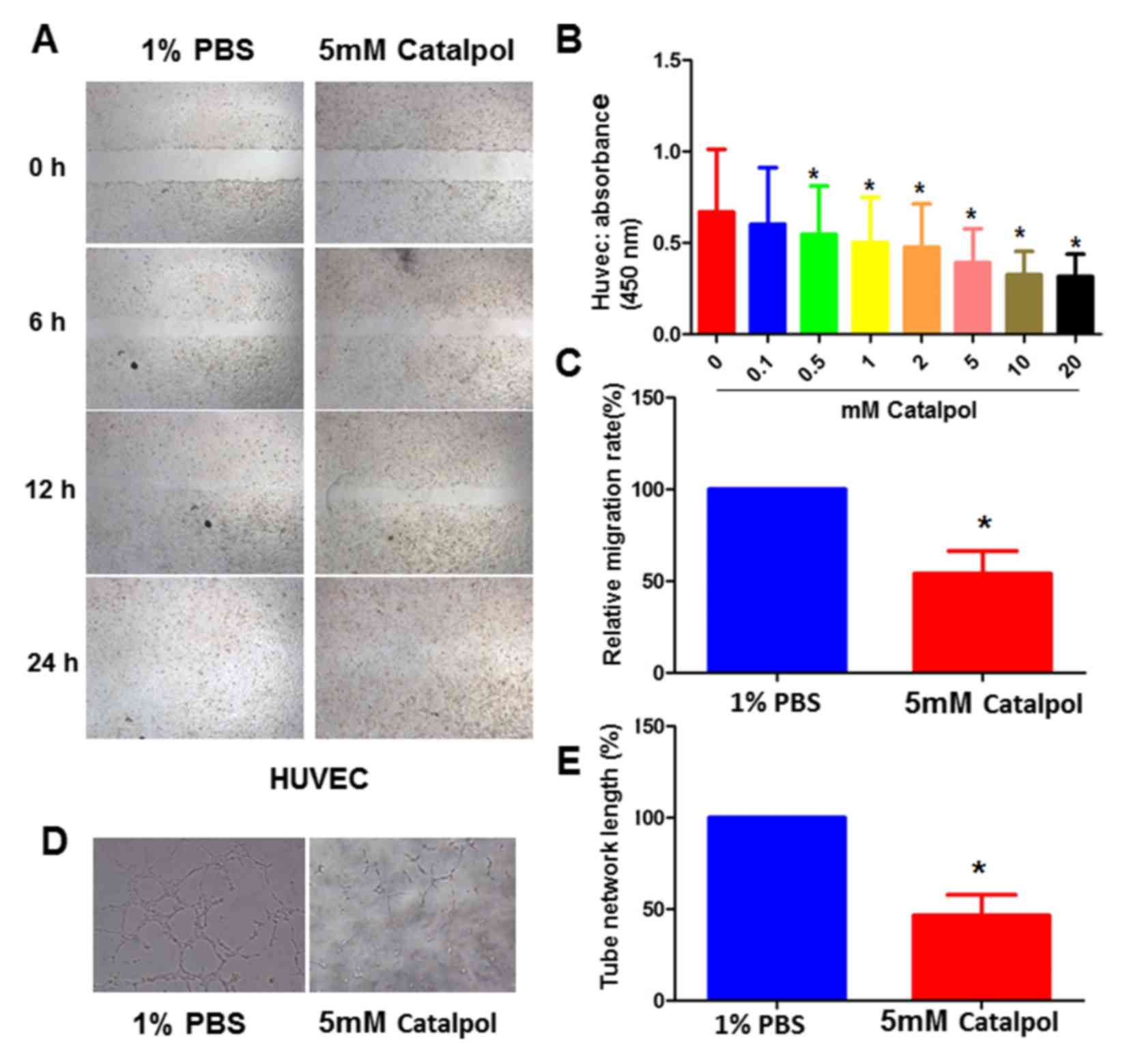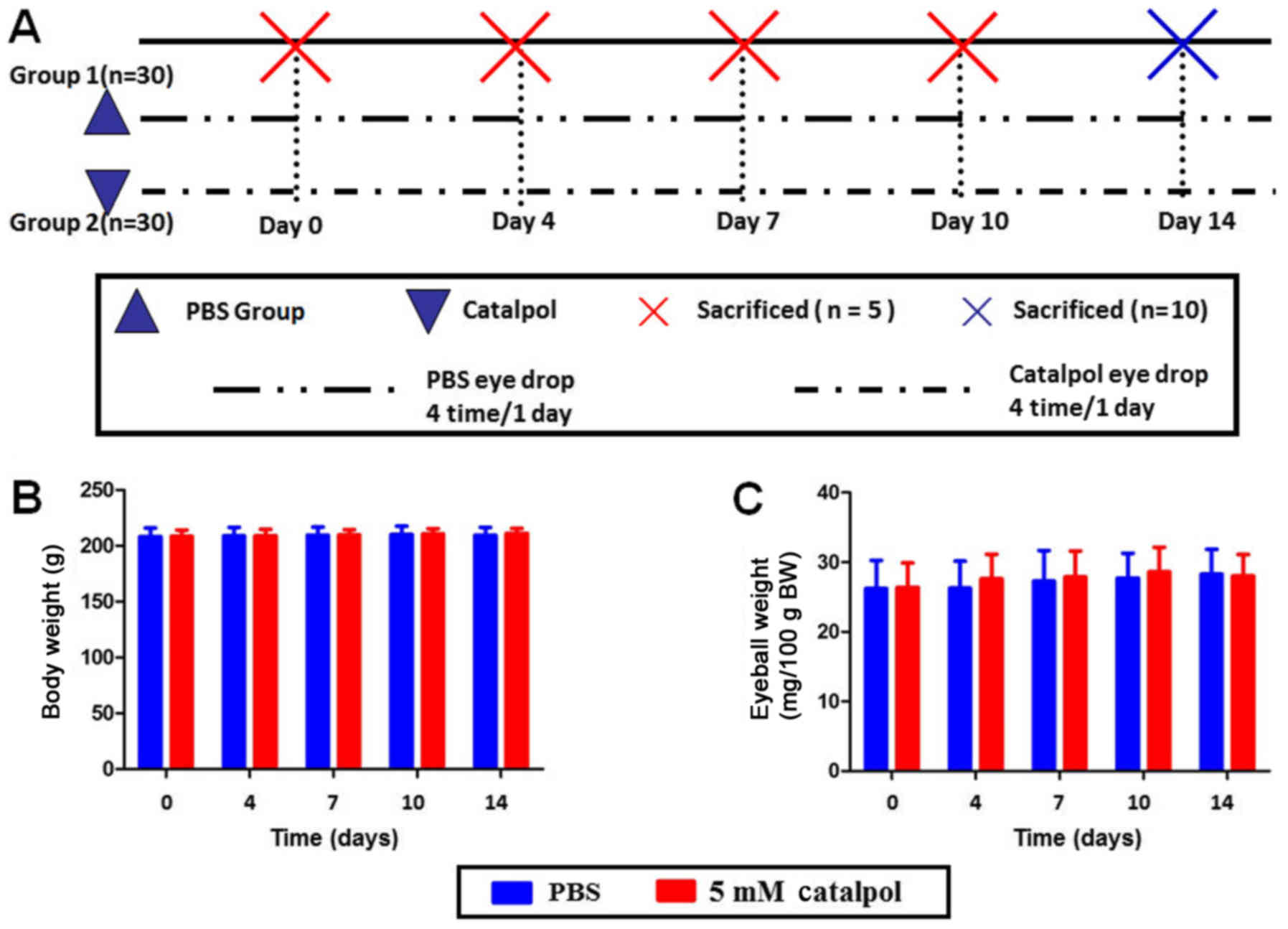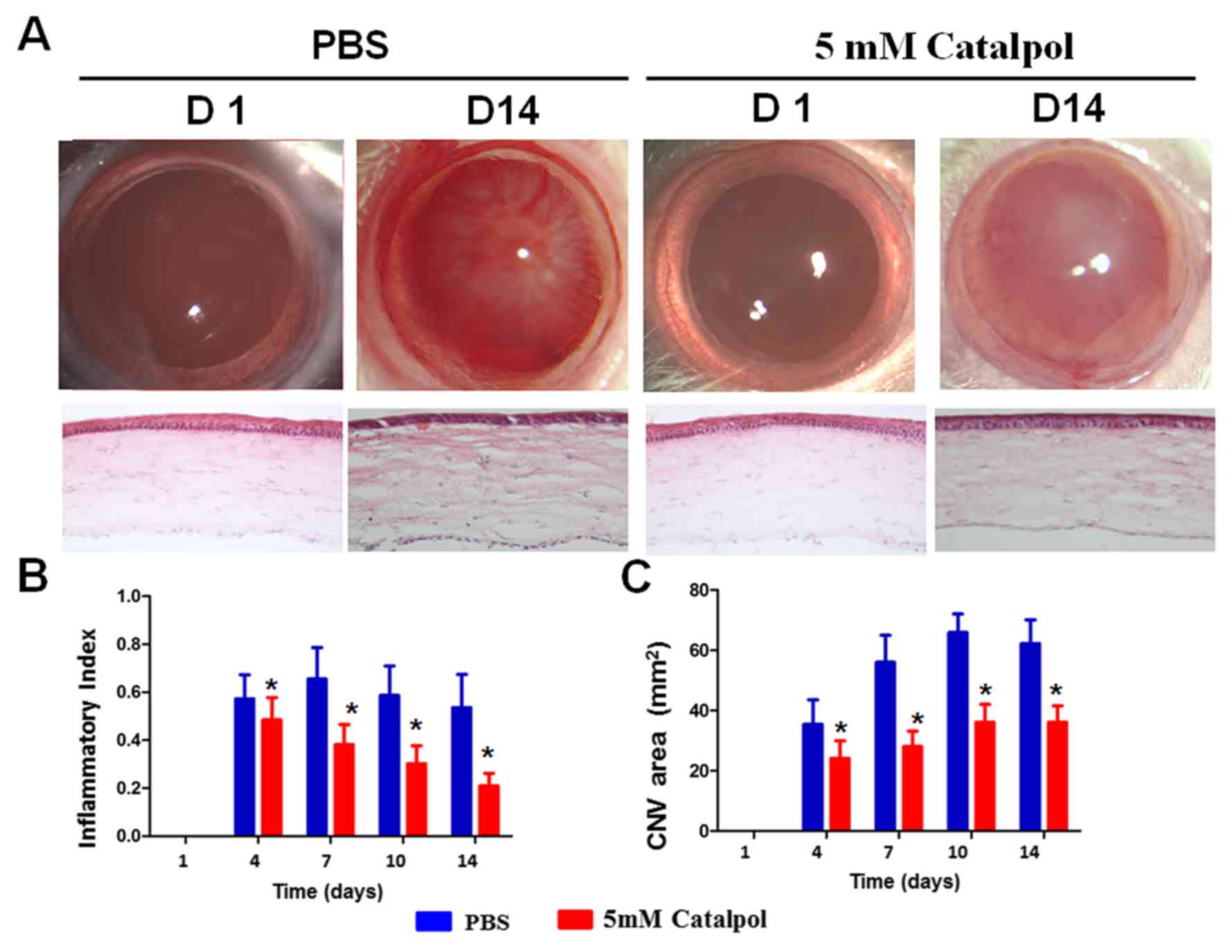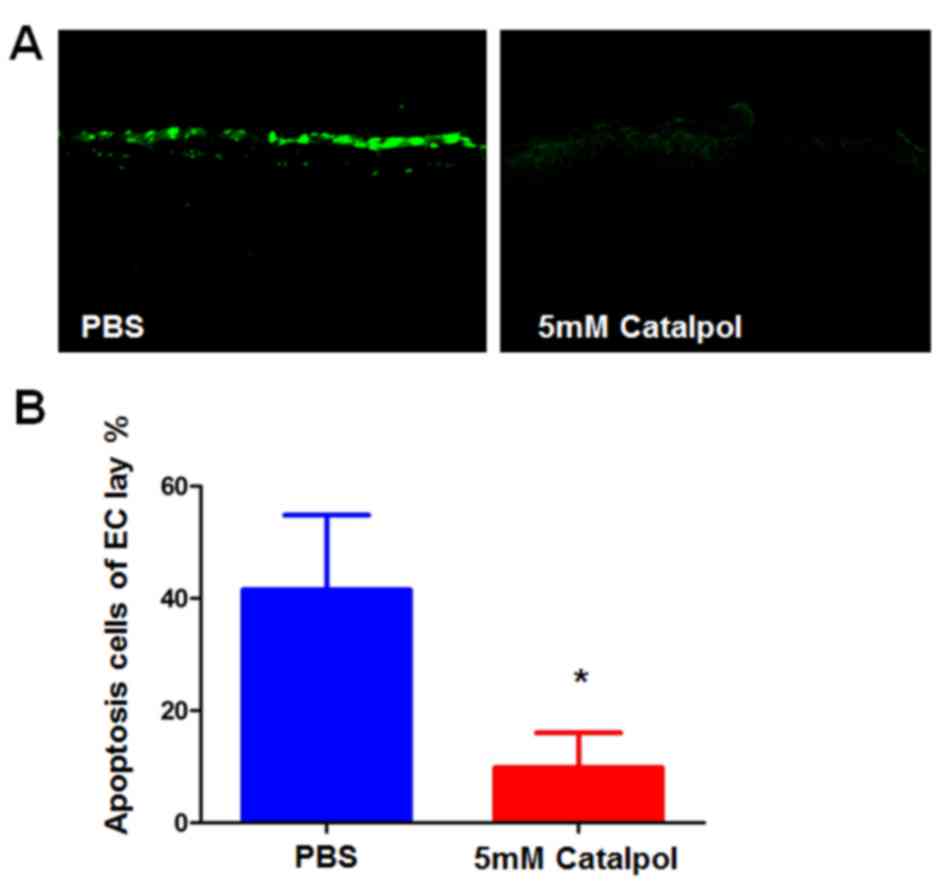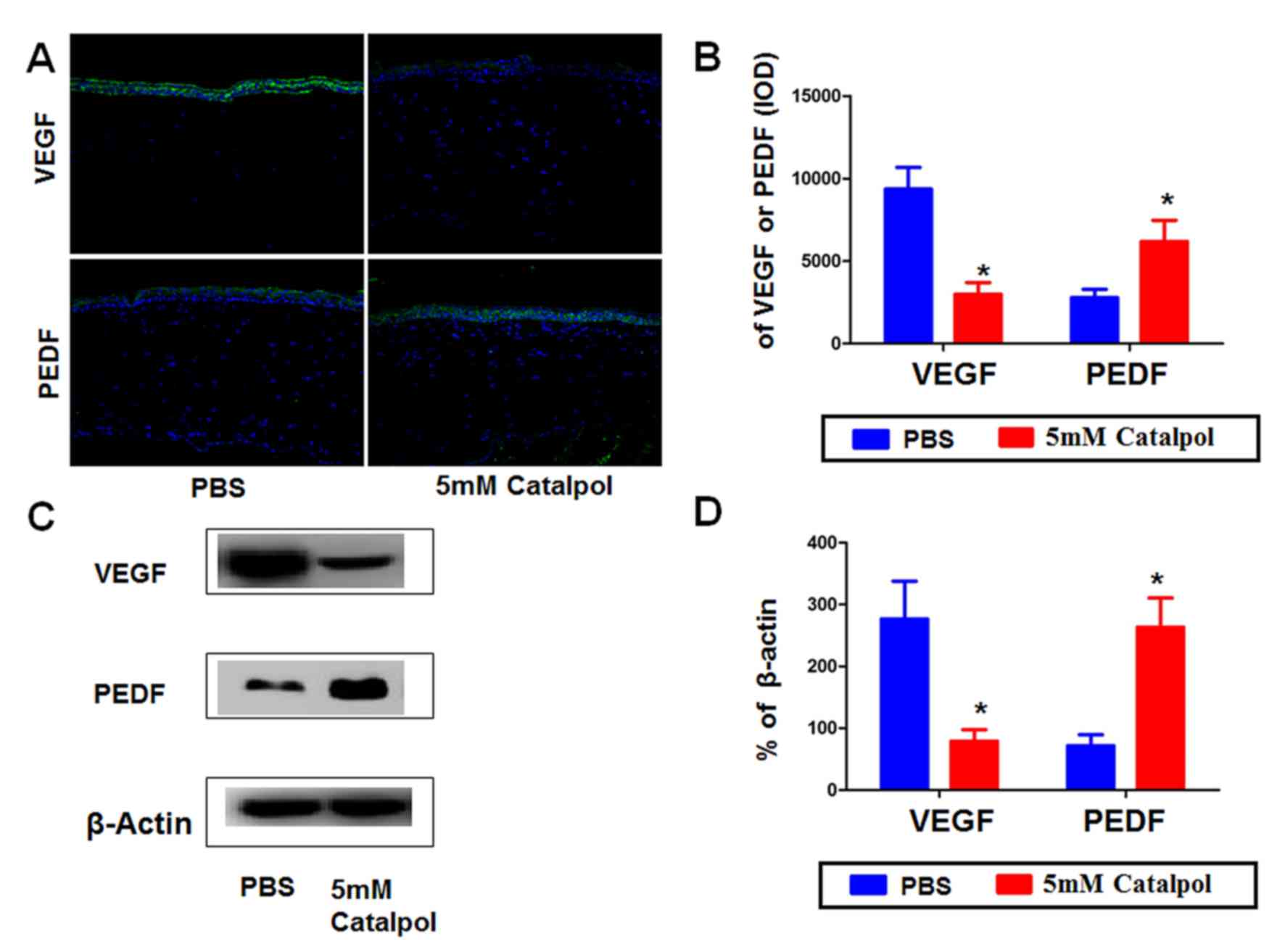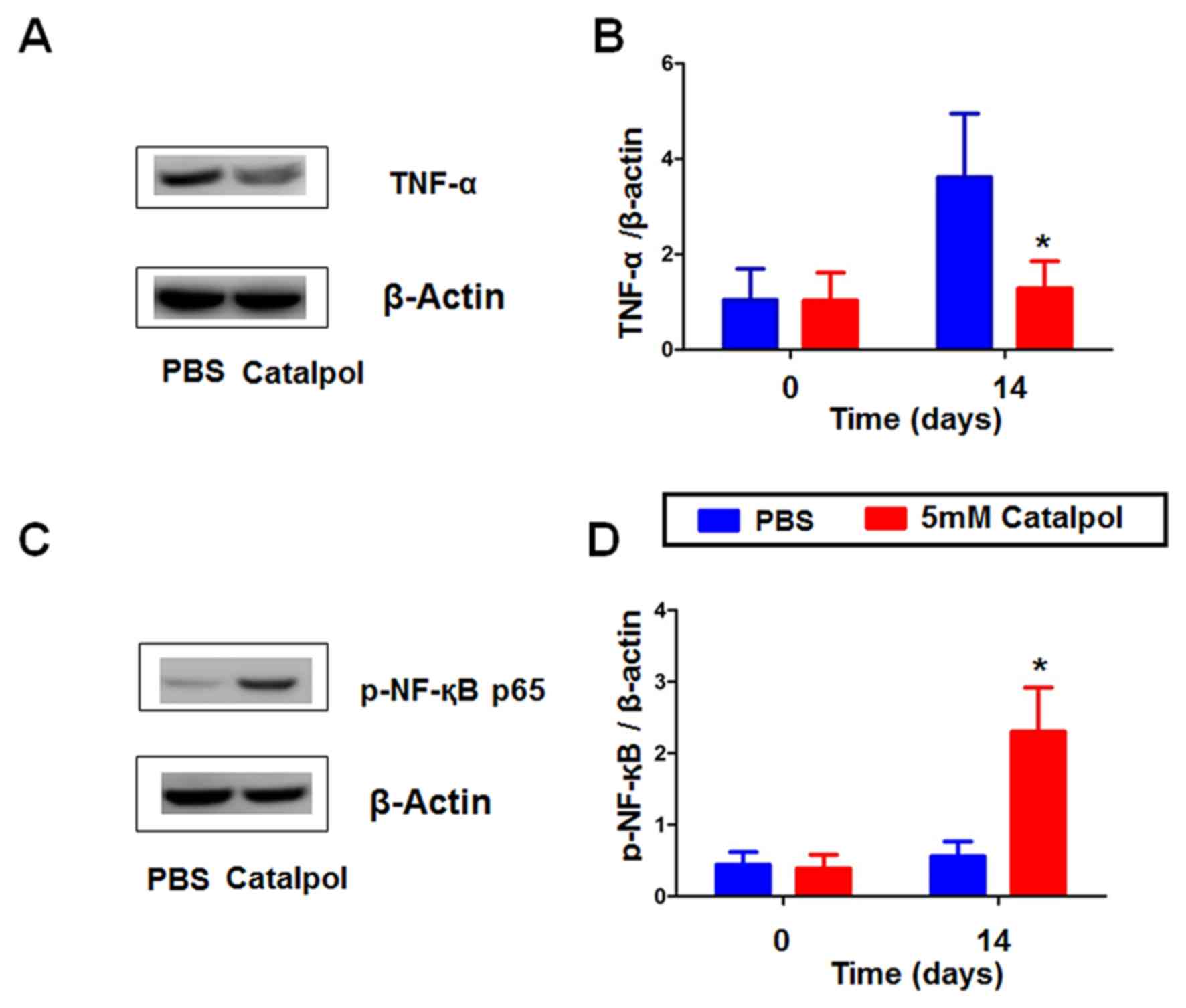|
1
|
Whitcher JP, Srinivasan M and Upadhyay MP:
Corneal blindness: A global perspective. Bull World Health Organ.
79:214–221. 2001.PubMed/NCBI
|
|
2
|
Hayashi K, Hooper LC, Detrick B and Hooks
JJ: HSV immune complex (HSV-IgG: IC) and HSV-DNA elicit the
production of angiogenic factor VEGF and MMP-9. Arch Virol.
154:219–226. 2009. View Article : Google Scholar : PubMed/NCBI
|
|
3
|
Zhang MC and Bian F: Emphasizing the
prevention and anti-inflammation research of dry eye disease.
Zhonghua Yan Ke Za Zhi. 49:6–7. 2013.(In Chinese). PubMed/NCBI
|
|
4
|
Liu YR, Lei RY, Wang CE, Zhang BA, Lu H,
Zhu HC and Zhang GB: Effects of catalpol on ATPase and amino acids
in gerbils with cerebral ischemia/reperfusion injury. Neurol Sci.
35:1229–1233. 2014. View Article : Google Scholar : PubMed/NCBI
|
|
5
|
Wang JH, Zou L, Wan D, Zhu HF, Wang Y and
Qin L: Review of Catalpol's pleiotropic signaling pathways. Zhong
Guo Yao Li Xue Tong Bao Bian Ji Bu. 9:1189–1194. 2015.(In
Chinese).
|
|
6
|
Bi J, Jiang B, Zorn A, Zhao RG, Liu P and
An LJ: Catalpol inhibits LPS plus IFN-γ-induced inflammatory
response in astrocytes primary cultures. Toxicol In Vitro.
27:543–550. 2013. View Article : Google Scholar : PubMed/NCBI
|
|
7
|
Wang Y, Zhang R, Xie J, Lu J and Yue Z:
Analgesic activity of catalpol in rodent models of neuropathic
pain, and its spinal mechanism. Cell Biochem Biophys. 70:1565–1571.
2014. View Article : Google Scholar : PubMed/NCBI
|
|
8
|
Han Y, Shao Y, Lin Z, Qu YL, Wang H, Zhou
Y, Chen W, Chen Y, Chen WL, Hu FR, et al: Netrin-1 simultaneously
suppresses corneal inflammation and neovascularization. Invest
Ophthalmol Vis Sci. 53:1285–1295. 2012. View Article : Google Scholar : PubMed/NCBI
|
|
9
|
Policy statements adopted by the Governing
Council of the American Public Health Association, November 15,
2000. Am J Public Health. 91:476–521. 2001. View Article : Google Scholar : PubMed/NCBI
|
|
10
|
Han Y, Shao Y, Liu T, Qu YL, Li W and Liu
Z: Therapeutic effects of topical netrin-4 inhibits corneal
neovascularization in alkali-burn rats. PLoS One. 10:e01229512015.
View Article : Google Scholar : PubMed/NCBI
|
|
11
|
Yu Y, Zou J, Han Y, Quyang L, He H, Hu P,
Shao Y and Tu P: Effects of intravitreal injection of netrin-1 in
retinal neovascularization of streptozotocin-induced diabetic rats.
Drug Des Devel Ther. 9:6363–6377. 2015.PubMed/NCBI
|
|
12
|
Huang X, Han Y, Shao Y and Yi JL: Efficacy
of the nucleotide-binding oligomerzation domain 1 inhibitor
Nodinhibit-1 on corneal alkali burns in rats. Int J Ophthalmol.
8:860–865. 2015.PubMed/NCBI
|
|
13
|
Arnaoutova I and Kleinman HK: In vitro
angiogenesis: Endothelial cell tube formation on gelled basement
membrane extract. Nat Protoc. 5:628–635. 2010. View Article : Google Scholar : PubMed/NCBI
|
|
14
|
Voiculescu OB, Voinea LM and Alexandrescu
C: Corneal neovascularization and biological therapy. J Med Life.
8:444–448. 2015.PubMed/NCBI
|
|
15
|
Ismailoglu UB, Saracoglu I, Harput US and
Sahin-Erdemli I: Effects of phenylpropanoid and iridoid glycosides
on free radical-induced impairment of endothelium-dependent
relaxation in rat aortic rings. J Ethnopharmacol. 79:193–197. 2002.
View Article : Google Scholar : PubMed/NCBI
|
|
16
|
Li DQ, Zhou N, Zhang L, Ma P and
Pflugfelder SC: Suppressive effects of azithromycin on
zymosan-induced production of proinflammatory mediators by human
corneal epithelial cells. Invest Ophthalmol Vis Sci. 51:5623–5629.
2010. View Article : Google Scholar : PubMed/NCBI
|
|
17
|
Choi HJ, Jang HJ, Chung TW, Jeong SI, Cha
J, Choi JY, Han CW, Jang YS, Joo M, Jeong HS and Ha KT: Catalpol
suppresses advanced glycation end-products-induced inflammatory
responses through inhibition of reactive oxygen species in human
monocytic THP-1 cells. Fitoterapia. 86:19–28. 2013. View Article : Google Scholar : PubMed/NCBI
|
|
18
|
Kleemann R, Zadelaar S and Kooistra T:
Cytokines and atherosclerosis: A comprehensive review of studies in
mice. Cardiovasc Res. 79:360–376. 2008. View Article : Google Scholar : PubMed/NCBI
|
|
19
|
Shao Y, Zhang Y, Yu Y, Xu TT, Wei R and
Zhou Q: Impact of catalpol on retinal ganglion cells in diabetic
retinopathy. Int J Clin Exp Med. 9:17274–17280. 2016.
|
|
20
|
Leung DW, Cachianes G, Kuang WJ, Goeddel
DV and Ferrara N: Vascular endothelial growth factor is a secreted
angiogenic mitogen. Science. 246:1306–1309. 1989. View Article : Google Scholar : PubMed/NCBI
|
|
21
|
Ferrara N and Davis-Smyth T: The biology
of vascular endothelial growth factor. Endocr Rev. 18:4–25. 1997.
View Article : Google Scholar : PubMed/NCBI
|
|
22
|
Phillips GD, Stone AM, Jones BD, Schultz
JC, Whitehead RA and Knighton DR: Vascular endothelial growth
factor (rhVEGF165) stimulates direct angiogenesis in the rabbit
cornea. In Vivo. 8:961–965. 1994.PubMed/NCBI
|
|
23
|
Liu JT, Chen YL, Chen WC, Chen HY, Lin YW,
Wang SH, Man KM, Wan HM, Yin WH, Liu PL and Chen YH: Role of
pigment epithelium-derived factor in stem/progenitor
cell-associated neovascularization. J Biomed Biotechnol.
2012:8712722012. View Article : Google Scholar : PubMed/NCBI
|
|
24
|
Ortego J, Escribano J, Becerra SP and
Coca-Prados M: Gene expression of the neurotrophic pigment
epithelium-derived factor in the human ciliary epithelium.
Synthesis and secretion into the aqueous humor. Invest Ophthalmol
Vis Sci. 37:2759–2767. 1996.PubMed/NCBI
|
|
25
|
Becerra SP: Focus on Molecules: Pigment
epithelium-derived factor (PEDF). Exp Eye Res. 82:739–740. 2006.
View Article : Google Scholar : PubMed/NCBI
|
|
26
|
Zhu HF, Wan D, Luo Y, Zhou JL, Chen L and
Xu XY: Catalpol increases brain angio-genesis and up-regulates VEGF
and EPO in the rat after permanent middle cerebral artery
occlusion. Int J Biol Sci. 6:443–453. 2010. View Article : Google Scholar : PubMed/NCBI
|
|
27
|
Liu JY: Catalpol protect diabetic vascular
endothelial function by inhibiting NADPH oxidase. Zhongguo Zhong
Yao Za Zhi. 39:2936–2941. 2014.(In Chinese). PubMed/NCBI
|
|
28
|
Liu X, Lin Z, Zhou T, Zong R, He H, Liu Z,
Ma JX, Liu Z and Zhou Y: Anti-angiogenic and anti-inflammatory
effects of SERPINA3K on corneal injury. PLoS One. 6:e167122011.
View Article : Google Scholar : PubMed/NCBI
|
|
29
|
Saika S, Miyamoto T, Yamanaka O, Kato T,
Ohnishi Y, Flanders KC, Ikeda K, Nakajima Y, Kao WW, Sato M, et al:
Therapeutic effect of topical administration of SN50, an inhibitor
of nuclear factor-kappaB, in treatment of corneal alkali burns in
mice. Am J Pathol. 166:1393–1403. 2005. View Article : Google Scholar : PubMed/NCBI
|
|
30
|
Chen M, Matsuda H, Wang L, Watanabe T,
Kimura MT, Igarashi J, Wang X, Sakimoto T, Fukuda N, Sawa M and
Nagase H: Pretranscriptional regulation of Tgf-beta1 by PI
polyamide prevents scarring and accelerates wound healing of the
cornea after exposure to alkali. Mol Ther. 18:519–527. 2010.
View Article : Google Scholar : PubMed/NCBI
|
|
31
|
Mochimaru H, Usui T, Yaguchi T, Nagahama
Y, Hasegawa G, Usui Y, Shimmura S, Tsubota K, Amano S, Kawakami Y
and Ishida S: Suppression of alkali burn-induced corneal
neovascularization by dendritic cell vaccination targeting VEGF
receptor 2. Invest Ophthalmol Vis Sci. 49:2172–2177. 2008.
View Article : Google Scholar : PubMed/NCBI
|
|
32
|
Zhang A, Hao S, Bi J, Bao Y, Zhang X, An L
and Jiang B: Effects of catalpol on mitochondrial function and
working memory in mice after lipopolysaccharide-induced acute
systemic inflammation. Exp Toxicol Pathol. 61:461–469. 2009.
View Article : Google Scholar : PubMed/NCBI
|



